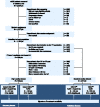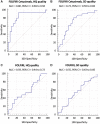Radiomics Response Signature for Identification of Metastatic Colorectal Cancer Sensitive to Therapies Targeting EGFR Pathway
- PMID: 32016387
- PMCID: PMC7492770
- DOI: 10.1093/jnci/djaa017
Radiomics Response Signature for Identification of Metastatic Colorectal Cancer Sensitive to Therapies Targeting EGFR Pathway
Abstract
Background: The authors sought to forecast survival and enhance treatment decisions for patients with liver metastatic colorectal cancer by using on-treatment radiomics signature to predict tumor sensitiveness to irinotecan, 5-fluorouracil, and leucovorin (FOLFIRI) alone (F) or in combination with cetuximab (FC).
Methods: We retrospectively analyzed 667 metastatic colorectal cancer patients treated with F or FC. Computed tomography quality was classified as high (HQ) or standard (SD). Four datasets were created using the nomenclature (treatment) - (quality). Patients were randomly assigned (2:1) to training or validation sets: FCHQ: 78:38, FCSD: 124:62, FHQ: 78:51, FSD: 158:78. Four tumor-imaging biomarkers measured quantitative radiomics changes between standard of care computed tomography scans at baseline and 8 weeks. Using machine learning, the performance of the signature to classify tumors as treatment sensitive or treatment insensitive was trained and validated using receiver operating characteristic (ROC) curves. Hazard ratio and Cox regression models evaluated association with overall survival (OS).
Results: The signature (area under the ROC curve [95% confidence interval (CI)]) used temporal decrease in tumor spatial heterogeneity plus boundary infiltration to successfully predict sensitivity to antiepidermal growth factor receptor therapy (FCHQ: 0.80 [95% CI = 0.69 to 0.94], FCSD: 0.72 [95% CI = 0.59 to 0.83]) but failed with chemotherapy (FHQ: 0.59 [95% CI = 0.44 to 0.72], FSD: 0.55 [95% CI = 0.43 to 0.66]). In cetuximab-containing sets, radiomics signature outperformed existing biomarkers (KRAS-mutational status, and tumor shrinkage by RECIST 1.1) for detection of treatment sensitivity and was strongly associated with OS (two-sided P < .005).
Conclusions: Radiomics response signature can serve as an intermediate surrogate marker of OS. The signature outperformed known biomarkers in providing an early prediction of treatment sensitivity and could be used to guide cetuximab treatment continuation decisions.
© The Author(s) 2020. Published by Oxford University Press. All rights reserved. For permissions, please email: journals.permissions@oup.com.
Figures





Comment in
-
The Evolving Status of Radiomics.J Natl Cancer Inst. 2020 Sep 1;112(9):869-870. doi: 10.1093/jnci/djaa018. J Natl Cancer Inst. 2020. PMID: 32016420 Free PMC article. No abstract available.
Similar articles
-
Continuation of Bevacizumab vs Cetuximab Plus Chemotherapy After First Progression in KRAS Wild-Type Metastatic Colorectal Cancer: The UNICANCER PRODIGE18 Randomized Clinical Trial.JAMA Oncol. 2019 Jan 1;5(1):83-90. doi: 10.1001/jamaoncol.2018.4465. JAMA Oncol. 2019. PMID: 30422156 Free PMC article. Clinical Trial.
-
FOLFIRI plus cetuximab versus FOLFIRI plus bevacizumab for metastatic colorectal cancer (FIRE-3): a post-hoc analysis of tumour dynamics in the final RAS wild-type subgroup of this randomised open-label phase 3 trial.Lancet Oncol. 2016 Oct;17(10):1426-1434. doi: 10.1016/S1470-2045(16)30269-8. Epub 2016 Aug 27. Lancet Oncol. 2016. PMID: 27575024 Clinical Trial.
-
Prognostic Effect of Adenosine-related Genetic Variants in Metastatic Colorectal Cancer Treated With Bevacizumab-based Chemotherapy.Clin Colorectal Cancer. 2019 Mar;18(1):e8-e19. doi: 10.1016/j.clcc.2018.09.003. Epub 2018 Sep 13. Clin Colorectal Cancer. 2019. PMID: 30293873 Free PMC article.
-
Chemotherapy of metastatic colorectal cancer.Prescrire Int. 2010 Oct;19(109):219-24. Prescrire Int. 2010. PMID: 21180382 Review.
-
Advanced image analytics predicting clinical outcomes in patients with colorectal liver metastases: A systematic review of the literature.Surg Oncol. 2021 Sep;38:101578. doi: 10.1016/j.suronc.2021.101578. Epub 2021 Apr 15. Surg Oncol. 2021. PMID: 33866191
Cited by
-
Radiomics analysis of baseline computed tomography to predict oncological outcomes in patients treated for resectable colorectal cancer liver metastasis.PLoS One. 2024 Sep 11;19(9):e0307815. doi: 10.1371/journal.pone.0307815. eCollection 2024. PLoS One. 2024. PMID: 39259736 Free PMC article.
-
Is precision medicine for colorectal liver metastases still a utopia? New perspectives by modern biomarkers, radiomics, and artificial intelligence.World J Gastroenterol. 2022 Feb 14;28(6):608-623. doi: 10.3748/wjg.v28.i6.608. World J Gastroenterol. 2022. PMID: 35317421 Free PMC article. Review.
-
Artificial intelligence and anti-cancer drugs' response.Acta Pharm Sin B. 2025 Jul;15(7):3355-3371. doi: 10.1016/j.apsb.2025.05.009. Epub 2025 May 21. Acta Pharm Sin B. 2025. PMID: 40698144 Free PMC article. Review.
-
Radiomics of Liver Metastases: A Systematic Review.Cancers (Basel). 2020 Oct 7;12(10):2881. doi: 10.3390/cancers12102881. Cancers (Basel). 2020. PMID: 33036490 Free PMC article. Review.
-
Radiomics in precision medicine for gastric cancer: opportunities and challenges.Eur Radiol. 2022 Sep;32(9):5852-5868. doi: 10.1007/s00330-022-08704-8. Epub 2022 Mar 22. Eur Radiol. 2022. PMID: 35316364 Review.
References
-
- Van Cutsem E, Cervantes A, Nordlinger B,. et al. Metastatic colorectal cancer: ESMO Clinical Practice Guidelines for diagnosis, treatment and follow-up. Ann Oncol. 2014;25(suppl 3):iii1–9. - PubMed
-
- Schwartz LH, Mazumdar M, Brown W, et al. Variability in response assessment in solid tumors: effect of number of lesions chosen for measurement. Clin Cancer Res. 2003;9(12):4318–4323. - PubMed
Publication types
MeSH terms
Substances
Grants and funding
LinkOut - more resources
Full Text Sources
Medical
Research Materials
Miscellaneous

